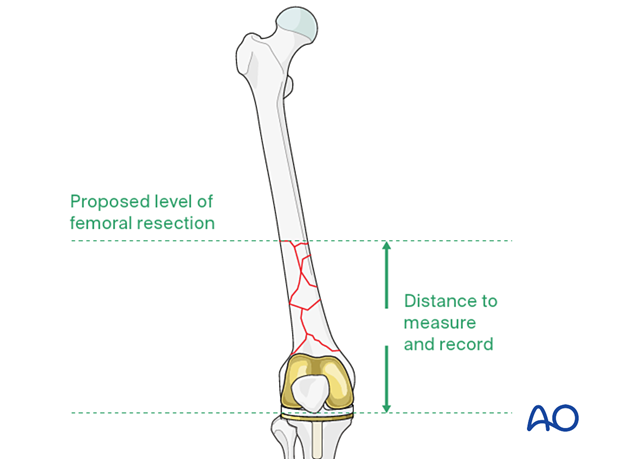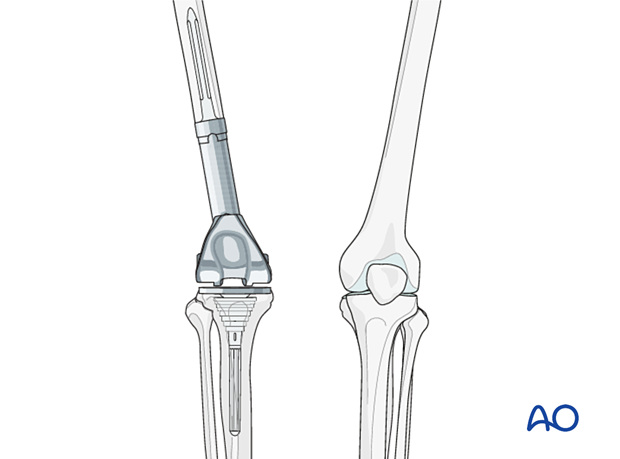Distal femoral replacement
1. Introduction
The distal femoral replacement prosthesis is indicated when there is either insufficient bone stock or poor bone quality.
The tibial component requires revision to be compatible with the new distal femoral replacement.

2. Preoperative planning
Templating
Templating is performed to determine the appropriate length of the distal femoral bone resection.

The minimum length of the distal femoral replacement prosthesis is generally in the range of 60-70 mm in most implant systems.

Additional intercalary segments are available to meet the reconstructive requirements.

Femoral stem
The minimum length of the stem for the distal femoral replacement prosthesis is typically 100-125 mm.

3. Patient preparation
The patient is placed in the supine position. A radiolucent table may facilitate intraoperative fluoroscopy if required.

4. Surgical approach
This procedure requires an adequate visualization of the knee joint. The most commonly used is a midline skin incision followed by a medial parapatellar arthrotomy. A proximal and distal extension may be necessary to achieve sufficient visualization and soft tissue releases.

5. Femur
Removal of femoral component
Dissection is carried out around the distal femur using the electric cautery. The collateral ligaments and the posterior joint capsule are detached from the distal femur. Care must be undertaken to avoid injury to the neurovascular structures, and to the extensor mechanism of the knee.

The femoral component is removed with the distal femur fracture fragments.
Additional bone resection may be necessary according to preoperative planning.

Preparation of the femur
The femoral resection level can be evened with a planer to optimize contact with the new prosthesis.

The femoral canal is prepared with reamers of increasing size. The depth of the reaming is determined by the length of the selected stem.

The diameter of the stem is determined by the reamer diameter which achieves cortical contact with the diaphyseal bone. One should allow for at least 2 mm of cement mantle around the stem if cement fixation is selected.

6. Tibia
Tibial revision techniques are described under the treatment: complete tibial revision with hinged knee.
7. Trial
The trial components are assembled, and a trial reduction is performed.

Leg length equalization techniques include:
- Matching with the preoperative measurement of the contralateral extremity using a radiopaque ruler.
- Intraoperative clinical evaluation if both legs have been prepped.

Patella tracking is carefully assessed to ensure no instability or impingement throughout the entire range of knee motion.

Proper rotational alignment of the femoral component is referenced to:
- Linea aspera
- Fluoroscopic rotational assessment using the lesser trochanter
- Patellar tracking during trial reduction
The anterior cortex of the femur is marked as reference for final insertion of the prosthesis.

8. Components insertion
Bone preparation for cementing
The femoral canal is lavaged and dried.
Cement restrictor
The cement restrictor is inserted into the femoral canal to allow for a 1 cm cement mantle between the stem tip and the restrictor.

Cementation
Cement is mixed using standard techniques and is inject into the canal with retrograde filling and pressurization, using a cement gun.

Insertion of femoral component
The femoral component is seated with rotational alignment to previously made marking during the trial reduction.

9. Final reduction
The selected polyethylene bearing along with the bushings for the hinged articulation are assembled and coupled together. The knee is reduced.

If patellar tracking is not ideal, a lateral retinacular release and medial imbrication can be performed.

10. Aftercare
The patient can be mobilized with full weight-bearing and active range of motion immediately after surgery.













